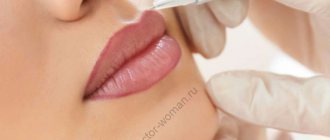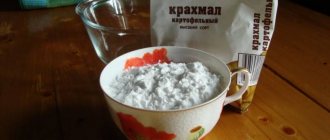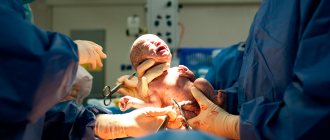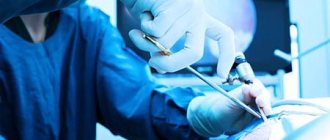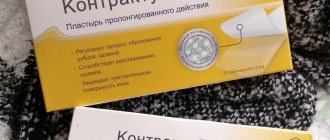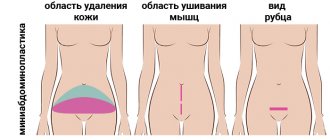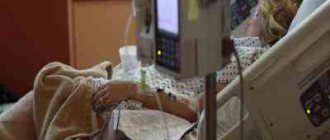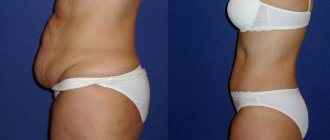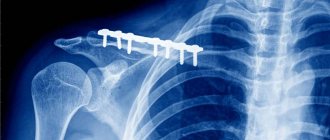In most cases, a cesarean section ends with the application of an external cosmetic suture, which heals with the formation of a thin, invisible scar. The duration of the recovery period and the quality of the scar formed largely depends on the care of the wound surface. Complications after the application of suture material are rare and can be successfully eliminated with timely consultation with a doctor. Over time, the appearance of the scar can be corrected through cosmetic, hardware, and surgical procedures.
Caesarean section (CS) is an abdominal operation, accompanied by sequential dissection of several layers of soft tissue, which, after removing the child, are connected using suture material.
In most cases, the edges of the external incision of the anterior abdominal wall are fixed by applying a cosmetic suture, after healing of which a thin, invisible scar is formed that does not cause physical and psychological discomfort to the patient.
How long does it take for a suture to heal after a caesarean section?
Operations are carried out as planned and urgently. In the first case, healing and recovery are faster. The second option is possible in case of complications during pregnancy or childbirth. For example, gestational diabetes, blood pressure, and chronic diseases in the expectant mother can lead to pathologies that require a cesarean section.
The uterus, peritoneum, muscles, and subcutaneous tissue are sutured in layers using self-absorbable threads. The same threads or material that requires subsequent removal may be applied to the skin.
A cesarean scar on the skin, in the absence of complications, heals quickly—within 7–14 days. Internal sutures dissolve within 1–3 months. During this period, you should not lift weights exceeding 5 kg; it is recommended to wear a postoperative bandage from the first day after delivery.
Pros and cons of argon plasma coagulation of the uterus
Argon plasma coagulation of the uterus has gained great popularity due to its many advantages. However, this operation also has disadvantages.
| pros | Minuses |
|
|
Healing process
Some people are concerned that the scar after the incision is hard and there are seals around it. This is not a dangerous condition - the tissues are damaged and need time to recover. After about 6 months with a vertical section and after 12-18 months with a horizontal section, the cesarean scar will fade, become soft and almost invisible.
Seals are not as scary as discharge from incisions. It happens that the seam oozes, gets wet, or even bleeds. Normally, there may be only a small amount of ichor and clear liquid. You should be wary if the suture is festering, bleeding is leaking, there are clots, or it looks strange - these situations require emergency intervention.
If the seam itches, this is normal. Itching begins 14–20 days after surgery and indicates that the skin is healing.
Feeling after surgery
The rehabilitation period largely depends on the individual characteristics of the mother's body, the professionalism of doctors and the quality of the operation performed. However, for some time, the vast majority of women after surgical delivery may experience discomfort of varying nature and intensity.
The following symptoms are normal:
- Moderate pain in the anterior abdominal wall for 3-5 weeks.
- Discharge of ichor (clear or yellowish liquid) with a slight admixture of blood from the wound during the first 5-8 days.
- The scar is convex and dense to the touch (up to 2 months after surgery).
- Moderate skin itching for 1-2 weeks after birth.
Even if the listed symptoms do not cause significant concern to the patient, they should be reported to the attending physician. If pain, itching, burning and discharge do not stop within the specified period or increase over time, mandatory medical attention is required.
Complications
One of the fears of pregnant women and already established mothers after surgery is the situation when the seam comes apart. This happens rarely and is possible due to poorly performed surgery, infection, heavy lifting, early removal of sutures, non-compliance with the rules of care and hygiene, as well as complications of pregnancy, such as gestational diabetes.
With this complication, the suture hurts, swells, turns red, sometimes festeres, and bleeds. In this case, additional manipulations will be required, including re-stitching.
Other postoperative pathologies:
- Inflammatory process. The fact that the seam is inflamed is indicated by pain, redness, and sometimes the temperature rises. The wound may ooze and fester.
- Ligature fistula. Late-period complication—occurs 1–2 months after surgery. It looks like an unevenly healed scar, in a separate area of which you can see that it has split apart. Fluid most often leaks from this fistula.
Hernias. They are more common in mothers for whom pregnancy and cesarean were not the first time. You can tell by lumps that don’t dissolve and cause discomfort.
If you suspect any deviation from the norm, you should see a doctor.
What scars after cesarean are called pathological?
A cesarean scar should normally turn into a normotrophic scar - it is thin and elastic, located at the same level with the skin and is almost the same in color. But it is possible to form a pathological scar, which:
- protrudes above the skin within the suture, may decrease over time (hypertrophic);
- grows beyond the wound, affecting healthy tissue (keloid);
- looks as if sunk inward (atrophic).
A cesarean scar on the skin heals faster than a scar on the uterus.
A scar on the uterus: why does it take so long to form and why is it important?
Where the uterus is dissected and sutured, connective tissue is formed and muscle fibers gradually grow. The internal suture scars up to 2 years and can form the following scar:
- Full (wealthy). Elastic, of sufficient thickness, without cavities. Will withstand subsequent stretching of the uterus during a second or subsequent pregnancy, as well as its contraction during childbirth.
- Insolvent (incompetent). It contains a lot of connective tissue that cannot stretch and contract. If you become pregnant again, there is a risk of scar thinning and uterine rupture.
The condition of the internal cesarean scar can only be determined by ultrasound. If the thickness of the scar on the uterus is more than 2 mm, there are no cracks or niches, then everything is in order. Sometimes, with a completely healed uterus after a cesarean section, natural birth is allowed if, according to the results of the examination, there are no indications for surgical delivery.
Types of external cuts and seams
Regardless of the position, size and other features of the incision on the uterus, the dissection of external tissues can be longitudinal and transverse. A longitudinal (vertical) incision is called a corporal cesarean section and is performed along the entire surface of the abdominal wall from the navel to the womb.
As a rule, this type of operation is performed only in emergency situations when emergency care is required for the mother or baby. In this case, due to the high risk of tissue divergence under load, their integrity is restored with a regular, rather than cosmetic, suture.
Other indications for corporal caesarean section:
- pronounced adhesions and inability to gain access to the lower segment of the uterus;
- varicose veins in the lower segment of the uterus;
- significant prematurity of the fetus and the unpreparedness of the woman’s body for childbirth (unformed lower uterine segment);
- planned removal of the uterus after surgery;
- the presence of a longitudinal scar after a previous operation;
- fetal pathology: transverse position, conjoined twins, etc.;
- the need to extract a living fetus from a dead or dying woman.
Currently, for uncomplicated planned CS, Pfannenstiel laparotomy is most often used, which provides the best aesthetic effect with high scar strength. A small transverse incision is made in an arc above the pubis. The resulting scar actually merges with the fold of skin in the lower abdomen and often becomes difficult to distinguish.
Removing stitches after cesarean
Today, cosmetic stitches are more often applied using self-absorbing threads that do not need to be removed. Typically, the threads gradually disappear 1–2 months after a cesarean section.
When making a vertical cut, denser materials are used - they must be removed. Usually the procedure is carried out 6–9 days after surgery. The doctor cuts off the ends of the suture with knots, and then carefully removes the threads.
The healing process is always individual. In many ways, proper care determines how long the stitch will take to heal.
Features of the cosmetic seam
The cosmetic seam has its own distinctive features:
- It is performed with atraumatic needles (the thread is a natural extension of the needle) and very thin threads.
- Passes inside the skin.
- Practically not visible on the surface of the skin.
- Forms a thin and invisible scar that does not cause discomfort.
When applying a cosmetic suture, the surrounding tissues are much less injured than when using the conventional technique of sewing through all layers of the skin. This technique not only allows you to achieve an optimal aesthetic result, but also significantly reduces the risk of complications and speeds up recovery.
A thin postoperative scar is formed through the use of special self-absorbing threads: silk, lavsan, vicryl or prolene. This material is able to withstand significant loads and ensure reliable healing of the postoperative wound.
Often, after discharge from the maternity hospital, women ask the question: how to remove a cosmetic stitch on their own? Obstetricians-gynecologists answer: there is no need to remove cosmetic intradermal sutures. After 70-120 days, the suture will resolve on its own without the use of any additional procedures. If complications develop (inflammation of the suture or divergence of the threads), it is necessary to urgently seek help from a doctor.
Lifestyle
To ensure that the scar after a cesarean section heals quickly, it is important to follow the following recommendations:
- Do not lift weights exceeding 5 kg. Any stress on the abs and abdomen is also strictly prohibited.
- Move more.
- Avoid hot baths, steam baths, saunas, and abdominal and back massage sessions.
- Wear underwear made from natural materials.
- Do not scratch the wound. You should absolutely not rub the scar, including with a washcloth.
- Wear a bandage.
Think over the menu. The vitamins and minerals contained in the products accelerate tissue scarring and are also beneficial for the nursing mother and baby. It is better to eat 5-6 times a day.
A menu for breastfeeding mothers is an ideal nutrition option, even if you are not breastfeeding. Minimize or eliminate sweet, spicy, fatty foods. Try to eat cereals, green vegetables and fruits, dairy products, and lean meat.
What is argon plasma coagulation during surgery?
Argon plasma coagulation during surgery is a variant of soft tissue incision under the influence of a physical factor: high-frequency current affects collagen fibers and destroys them, and high temperature causes coagulation of the underlying structures, since the main components - proteins - are destroyed under the influence of current and temperature. This process is called coagulation.
The main active ingredient is the inert gas argon. The laser penetration depth is 3-5 millimeters, and high precision allows for the most gentle treatment of tissue. The plasma cut is faster and more accurate than a surgical scalpel. It passes along the anterior wall of the abdomen and is carried through the uterus.
How to remove a cesarean scar
A cosmetic seam often looks quite aesthetically pleasing, but not everyone has it that way. Every woman wants a seam not to mar the appearance of her belly. You can choose the appropriate correction option.
Home methods
For young scars, silicone-containing gels, creams, and plates are suitable. They moisturize and soften the skin, normalize water balance, and prevent pathological tissue growth. If a protruding scar has already appeared, then you can use agents that destroy scar tissue (with collagenase, hyaluronidase).
In the case of mature scars, cosmetic products alone are not enough. You can resort to physiotherapy. There are devices for use at home that help you quickly achieve the desired results. Electrophoresis and phonophoresis, ultrasound are widely used.
Medical methods
This is more efficient and reliable, but is not suitable for everyone. You can get rid of a scar after a cesarean section with the help of interventions such as:
- Plastic. If the scar is already formed and looks unaesthetic, or there is a scar defect, the operation can be performed using laparoscopic, vaginal, hysteroscopic or laparotomic access.
- Laser. A full treatment course of 5–10 procedures is required, and each manipulation is quite painful, since the tissue is removed layer by layer.
- Mechanical grinding. A more gentle method, including 6-8 sessions. The scar is exfoliated with aluminum oxide microparticles.
Peels with fruit acids and chemical compounds are also used, but they are ineffective for pronounced scars.
Re-suturing
In advanced cases, surgeons are forced to completely excise the existing scar and re-apply the ligature. It depends on how badly the muscle layers, subcutaneous tissue and skin are damaged. Often, the cosmetic stitch is replaced with a regular one.
The rehabilitation period after repeated surgery increases several times, and the newly formed scar will be more convex, rougher and noticeable. Therefore, if any suspicious symptoms occur that indicate disturbances in normal wound healing, you must immediately seek medical help to avoid serious consequences.
